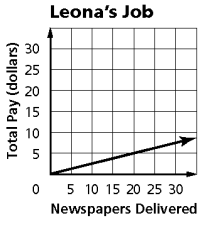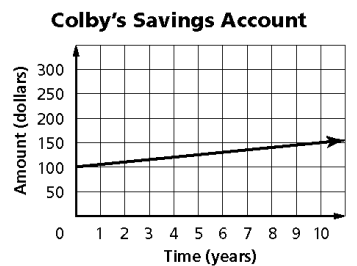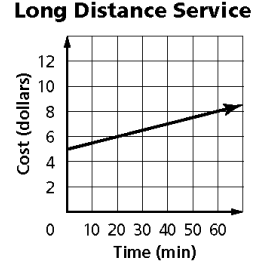INTERPRETING LINEAR FUNCTIONS WORD PROBLEMS WORKSHEET
Problem 1:
Charlie worked for a stone setting company this past summer. He earned $50 just for coming to work and an additional $30 every hour for each hour he worked. The linear function E(t) = 50 + 30t represents Charlie’s earnings E as a function of time worked t (in hours).
a) Explain what E(4) represents.
b) Find E(8). Explain what this represents in this problem.
c) Find E(5) - E(2).
Explain what this represents in this problem.
Problem 2 :
Kristen has $500 in her savings account. She is able to save $50 each month. The function S(m) = 50m + 500 represents the amount of money in her savings account S as a function of time in months m.
a) Find S(2). Explain what this represents in this problem.
b) Find m such that S(m)=800. Explain what this represents in this problem.
Problem 3 :
Luke is driving home from work. Let D(t) denote Luke’s remaining distance to drive D (measured in miles) after t minutes of driving.
What does the statement D(0) = 10 mean?
a) The drive between Luke’s home and his workplace takes 10 minutes.
b) The drive between Luke’s home and his workplace is 10 miles long.
c) Luke’s remaining distance is 0 miles after 10 minutes.
Problem 4 :
Ryan’s class had a math quiz where the grades were between 0 and 10. Let N(g) denote the number of students N whose grade on the exam was g.
What does the statement N(K) = 8 mean?
a) There are 8 students whose grade on the exam was K.
b) The value of the unknown K is equal to 8.
c) There are K students whose grade on the exam was 8.
Problem 5 :
Alicia went for a walk. Let D(t) denote the distance Alicia walked D (measures in miles) after walking for t hours.
What does the statement D(0.5) < D(1) - D(0.5) mean?
a) The distance Alicia has walked after walking for an hour is greater than the distance she has walked after half an hour.
b) The time it took Alicia to walk the first half mile is shorter than the time it took her to walk the following half mile.
c) The distance Alicia walked during the first half hour is shorter than the distance she walked during the following half hour.
Answer Key
1)
a) E(4) represents the money earned by Charlie working for 4 hours. He is earning $170 for 4 hours.
b) Charlie earning $290 after working for 8 hours at stone cutting company.
c) E(5) - E(2) = 90
2)
a) S(2) = 600
S(2) represents the amount of money in her saving accounts in 2 months.
b) After 6 months, he will have 800.
3) The drive between Luke’s home and his workplace is 10 miles long.
4) There are 8 students whose grade on the exam was K.
5) The distance Alicia walked during the first half hour is shorter than the distance she walked during the following half hour.
Problem 1 :
The function below shows the cost of a hamburger with different numbers of toppings (t).
f(t) = 1.90 + 1.40t
a) What is the y-intercept, and what does it mean?
b) What is the slope, and what does it mean?
c) If Jodi paid $3.30 for a hamburger, how many toppings were on Jodi’s hamburger?
Problem 2 :
The function below shows the cost of an ice cream sundae with different numbers of toppings (t).
f(t) = 2.25 + 0.75t
a) What is the y-intercept, and what does it mean?
b) What is the slope, and what does it mean?
Problem 3 :
The graph below shows the number of newspapers delivered and total pay for Leona’ newspaper delivery job. What does the slope ?

Problem 4 :
Dionne pays a fixed fee plus an hourly rate to rent a boat. The table below shows how much Dionne paid for the boat. What was Dionne’s hourly rate to rent the boat?

Problem 5 :
Colby put $100 in a savings account. The graph below shows how the amount in the account would increase over the next ten years. What does the y-intercept represent?

Problem 6 :
Tara pays a base rate for her long distance phone service plus a per-minute charge. The graph below shows what she would pay for her long distance phone service for the first 60 minutes. What does the y-intercept of this graph represent?

Problem 7 :
Rich is a member of a gym. He pays a monthly fee plus a per-visit fee. The equation below represents the monthly amount Rich pays for his membership to the gym per month for x visits.
y = 3x + 10
What does the y-intercept of the graph of this equation represent?
Answer Key
1) a) $1.90
b) Slope = 1.40, Here the meaning of slope is how the charge is being affected for every increase of one topping.
c) t = 1
2) a) $2.25
b) For every one increase of topping, we have to pay 0.75 more.
3) m = 1/4
4) hourly rate is $12
5) $100
6) The base rate is $5.
7) Membership of the gym is $10 and per visit he has to pay $3.
Recent Articles
-
Finding Range of Values Inequality Problems
May 21, 24 08:51 PM
Finding Range of Values Inequality Problems -
Solving Two Step Inequality Word Problems
May 21, 24 08:51 AM
Solving Two Step Inequality Word Problems -
Exponential Function Context and Data Modeling
May 20, 24 10:45 PM
Exponential Function Context and Data Modeling